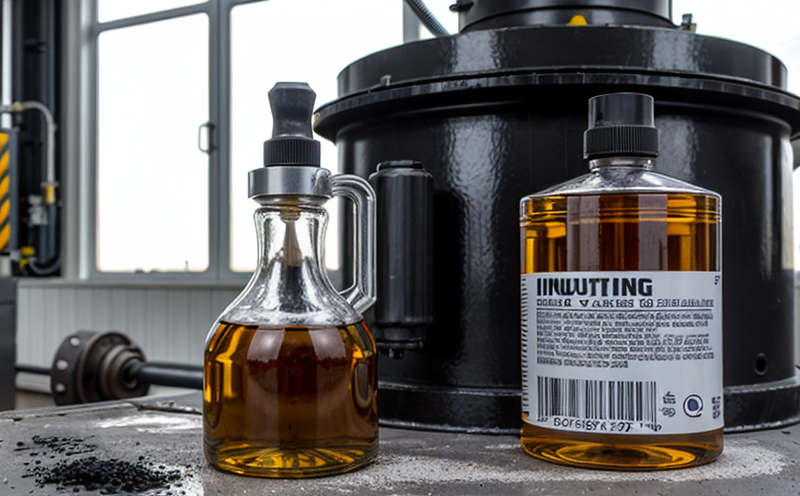ISO 6245 Insoluble Matter Testing in Industrial Oils
The ISO 6245 standard provides a comprehensive framework for quantifying insoluble matter content in industrial oils. This testing is critical for quality assurance, ensuring that the oil meets specifications and performs optimally under various operating conditions. Understanding the presence of insoluble particles can help prevent equipment failures, reduce maintenance costs, and extend the useful life of machinery.
Insoluble matter refers to non-combustible solid residues remaining after burning an oil sample in a crucible at 500°C for five hours. This residue includes various contaminants such as dirt, dust, metal shavings, wear debris, and other foreign materials. The test method outlined in ISO 6245 is designed to detect these particles down to a size of approximately 10 micrometers.
The procedure involves several steps: sampling the oil, preparing the sample for testing by filtering it through specific filters, placing the filtered sample into a crucible, and then subjecting it to high-temperature combustion. The resulting residue is weighed to determine the percentage of insoluble matter in the original oil sample.
For accurate results, proper specimen preparation is crucial. This includes ensuring that the sample is representative of the entire batch or container from which it was drawn. Contaminants can be introduced during handling if care is not taken, so using clean equipment and following standard procedures helps maintain integrity.
The ISO 6245 method has been widely adopted in industries where lubricant quality significantly impacts machinery reliability and operational costs. By adhering to this protocol, manufacturers and users of industrial oils can ensure consistent performance and longevity across their fleet of equipment.
| Applied Standards |
|---|
| ISO 6245:1998 specifies the procedure for determining insoluble matter in used lubricating oil. It details the requirements for crucibles, filters, and other equipment needed to conduct accurate tests. |
The standard also includes recommendations on how often testing should be performed based on usage conditions and expected wear levels of machinery components.
- For high-risk applications such as turbines or critical bearings, frequent monitoring (every three months) may be necessary.
- In less demanding environments, periodic checks every six months to one year could suffice.
Understanding the implications of insoluble matter content is essential for maintaining efficient operations. High levels can lead to premature wear and increased friction within machinery, which translates into higher energy consumption and reduced productivity over time.
In summary, ISO 6245 provides a robust methodology for quantifying insoluble matter in industrial oils, offering valuable insights into the condition of lubricants used throughout various sectors. Adhering to these guidelines ensures optimal performance and longevity of machinery while minimizing operational disruptions due to unexpected failures.
Applied Standards
| Applied Standards |
|---|
| ISO 6245:1998 specifies the procedure for determining insoluble matter in used lubricating oil. It details the requirements for crucibles, filters, and other equipment needed to conduct accurate tests. |
The standard also includes recommendations on how often testing should be performed based on usage conditions and expected wear levels of machinery components.
- For high-risk applications such as turbines or critical bearings, frequent monitoring (every three months) may be necessary.
- In less demanding environments, periodic checks every six months to one year could suffice.
The ISO 6245 method ensures that the testing process is consistent across different laboratories and operators, enhancing reliability and comparability of results. Compliance with this standard guarantees adherence to industry best practices when assessing the quality of industrial oils.
International Acceptance and Recognition
- Australia: The Australian Industrial Lubricants Association (AILA) recommends ISO 6245 as a key performance indicator for lubricant quality assessment.
- Canada: Canadian Standards Association (CSA) references ISO 6245 in its guidelines for industrial lubricant selection and application.
- European Union: The European Committee for Standardization (CEN) includes ISO 6245 within its portfolio of recognized standards for lubricants.
- United States: American Society for Testing and Materials (ASTM) provides detailed guidance on using ISO 6245 during oil analysis programs aimed at improving asset management strategies.
The widespread adoption of ISO 6245 underscores its importance in maintaining high standards of lubricant quality worldwide. Its acceptance by major regulatory bodies and industry associations ensures that the results from this testing method are universally accepted, facilitating smoother international trade and collaboration between organizations.
Environmental and Sustainability Contributions
The ISO 6245 test plays a crucial role in promoting environmental sustainability within industrial settings by helping companies identify potential sources of contamination early on. This allows for proactive measures to be taken, reducing the amount of waste generated from discarded oils that contain excessive amounts of insoluble matter.
By preventing overuse of lubricants and addressing issues related to wear debris buildup, ISO 6245 supports more efficient resource utilization practices. Additionally, adhering to this standard helps minimize environmental impact through better management of hazardous materials associated with used industrial oils.
Incorporating advanced filtration systems based on ISO 6245 findings can lead to significant reductions in emissions and energy consumption during manufacturing processes. Such improvements contribute positively towards achieving broader sustainability goals set forth by various global initiatives aimed at reducing carbon footprints across all sectors.





